Characteristics & Strategy
Portfolio Structuring Strategy
The investment corporation's basic strategy for portfolio design is to consist of the rental housing sector and the healthcare facility sector in the following percentage and regional ratio.
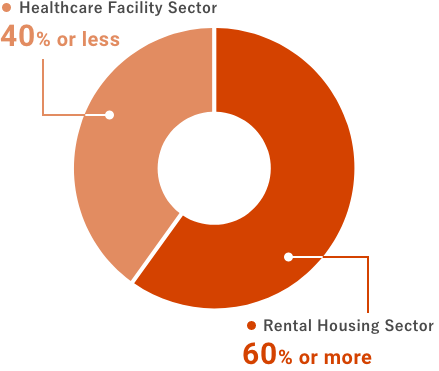
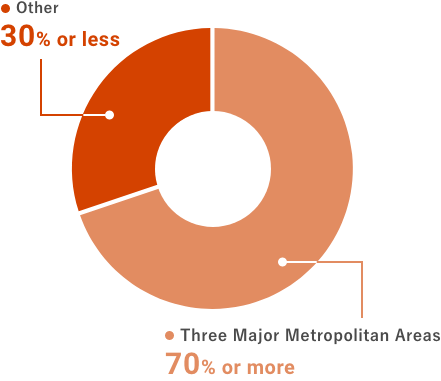
Rental Housing Sector Strategy
1.The allocation of property types
We focus on the fact that the manner of using a rental apartment differs depending on the user's household structure, income, age and other factors, and that the demand trend also differs by the class of users. Based on that understanding, we arrive upon our investment decisions for responding to the needs of a diversified set of users by considering factors such as changes in household structure, changes in user perception toward housing and regional characteristics. It is our policy to conduct investment by selecting properties that will create a stable income and to combine the properties based on the following investment ratio. The selection is made from two categories - studio type and family type.
| Studios | Family Units | |
|---|---|---|
| Household Type | Single-person or DINKS (Double Income No Kids households) | Households with children etc. |
| Layout | 1R, 1K, 1DK, 1LDK | 2K, 2DK, 2LDK and above |
| Location/Living Environment | As a rule, within a 5-minute walking distance from major mass transit facilities. Highly convenient location for living purposes. |
As a rule, within a 12-minute walking distance from major mass transit facilities or with a certain number of parking spots. Highly convenient location for living purposes, in close proximity to educational and commercial facilities. Should not be located close to unfavorable sites (such as waste incineration facilities). |
| Inclusion Ratio | 50 - 80% | 20 - 50% |
2.Diversified investment in rental housing across Japan, with focus on the 23 wards of Tokyo and three major metropolitan areas
Rental apartments are located nationwide based on the population distribution. We make nationwide investments in order to take advantage of steady demand for rental apartments, with a focus on the 23 wards of Tokyo and the three major metropolitan areas, to benefit from existing earning opportunities in other cities and to lower the risk of concentrated investments in any one specific area.

3.Target proportion of investment


- Investment ratios are based on acquisition prices.
- The three major metropolitan areas mean the Kanto metropolitan area, excluding 23 wards of Tokyo, the Chukyo metropolitan area, and the Kinki metropolitan area.
- Other major cities mean Sapporo, Sendai, Niigata, Shizuoka/Hamamatsu, Okayama, Hiroshima, Kitakyushu/Fukuoka and Kumamoto metropolitan areas and cities with a population of 300,000 or more.
Healthcare Facility Sector Strategy
The investment corporation believes that demand for facilities and housing for the elderly will continue to increase as the aging of the population progresses and the number of single-person households for the elderly and married couples for the elderly increases.
For the time being, based on this view, the government will focus on facilities and housing for the elderly among healthcare facilities.
In addition, among the facilities and housings for the elderly, the number of facilities utilizing private funds is expected to increase significantly in the future due to the fact that it can be operated by a joint-stock company. The investment targets will be mainly fee-based nursing homes and housings for the elderly with services, which are considered to have high social demands.
1.The allocation of property types
| Classification of healthcare facility | Private nursing homes and other facilities for the elderly | Medical facilities | Other | ||
| Fee-based homes for the elderly (Note 1) (with nursing care /health-type / residential-type) | Elderly housing withsupportive services (Note 2) | Other private nursinghomes and facilities for the elderly | |||
| Incorporation ratio (Note 3) |
60% or more | 40% or less | 10% or less | ||
- “Fee-based homes for the elderly” refers to facilities as defined by Article 29 of the Act on Social Welfare for the Elderly. However, this excludes facilities that fall under the category of elderly housing with supportive services.
- “Elderly housing with supportive services” refers to rental housing registered by prefectures that meet the registration criteria stipulated by the Act on Securement of Stable Supply for Elderly Persons’ Housing.
- “Incorporation ratio” is based on acquisition price (not including taxes and other expenses associated with acquisition).
2.Diversified investment in healthcare facilities nationwide, mainly in the Three Major Metropolitan Areas of the Greater Tokyo area, Chukyo area, and Kinki area
In the healthcare facilities business, we will invest in healthcare facilities nationwide from the perspective of diversifying portfolio risks, focusing on the Three Major Metropolitan Areas of Tokyo, Chukyo, and Kinki, where populations are concentrated and the elderly are expected to be concentrated.
3.Target proportion of investment

- Investment ratios are based on acquisition prices.
- “Three Major Metropolitan Areas” refers to the greater Tokyo area (Tokyo, Kanagawa, Chiba and Saitama prefectures), the Chukyo area (Aichi, Mie and Gifu prefectures) and the Kinki area (Osaka, Kyoto, Hyogo, Nara and Shiga prefectures).
- The “Core City Areas” refers to cities outside the Three Major Metropolitan Areas with populations of 200,000 or more.
- “Other” refers to cities outside the Three Major Metropolitan Areas and the Core City Areas with populations under 200,000.
- Types and overview of healthcare facilities
-
Daiwa Securities Living Investment Corporation (DLI) believes that demand for private nursing homes and other facilities for the elderly will continue to increase in the future alongside the development of the aging society and the increase of elderly persons living alone and households consisting solely of elderly couples. Based on this belief, DLI will focus investment for the time being on private nursing homes and other facilities for the elderly among healthcare facilities. Furthermore, from among this category DLI will primarily invest in fee-based homes for the elderly and elderly housing with supportive services, as such are expected to increase significantly with the use of private funds in the future since they can be managed by corporations and are thought to have high social demand.
Classification of healthcare facility Overview Private nursing homes and other facilities for the elderly Fee-based homes for the elderly Facilities that provide seniors with services such as nursing care, meals, laundry, cleaning, other household care and healthcare necessary for daily living (excludes welfare facilities, group homes, etc.) With nursing care Fee-based homes for the elderly designated for “long-term care for residents of specified facilities” (designated as “Specified Facilities”) under the Long-Term Care Insurance Act Health-type Fee-based homes for the elderly not designated as Specified Facilities where seniors must terminate their contract and leave if nursing care becomes necessary Residential-type Fee-based homes for the elderly that are not designated as a Specified Facilities and which are not health-type homes (external nursing care insurance services will be used if nursing care becomes necessary) Elderly housing with supportive services Registered rental housing that meet the standards of residence (floor area, facilities and structure), services for residents and contract with residents Other private nursing homes and other facilities for the elderly Other nursing care facilities and residential facilities targeting the elderly for residency and use Medical facilities Hospitals and medical malls Other Life science facilities (facilities occupied by companies or individuals engaged in the life science industry dealing with biotechnology, pharmaceuticals or the development of medical devices) Facility overview of private nursing homes and other facilities for the elderly
Residential room 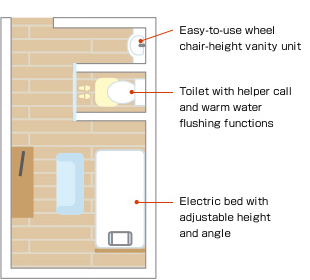
Common use area 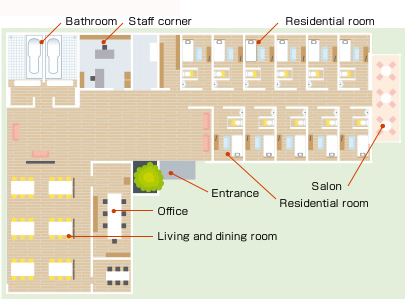
Required fees(rent,etc.) - Rent:
Compensation required for use of residential room and common use area - Common use fee:
Common use fee: Compensation required for the maintenance and management of the common use area - Utilities:
Water charges and electricity charges for lights, etc.
- Utilities of residential rooms may also be paid individually to water and electric power suppliers.
- Assets acquired by Daiwa Securities Living Investment Corporation and healthcare facilities to be acquired in the future are not necessarily equipped with all of the facilities above.
Overview of services of private nursing homes and other facilities for the elderly
- Meal services
- Provision of meals
- Provision of therapeutic food
- Household support services
- Cleaning of residential rooms
- Washing of clothes
- Life support services
- Shopping
- Assistance for going out and transport to hospital
- Recreational activities
- Watching over daily living
- Healthcare services
- Health counseling
- Medication management
- Cooperation with medical institutions
- Emergency response
- Nursing care services
- Physical care
- Watching over dementia
- Functional training
- End-of-life care
Required fees(food expenses, etc) - Food expenses:
Compensation required for the provision of meals (expenses for ingredients, cooking, etc.) - Service charges:
Compensation required for services such as household support,healthcare, life support, nursing care, etc.
- Assets acquired by Daiwa Securities Living Investment Corporation and healthcare facilities to be acquired in the future do not necessarily provide all of the services above.
Differences in provision of nursing care services
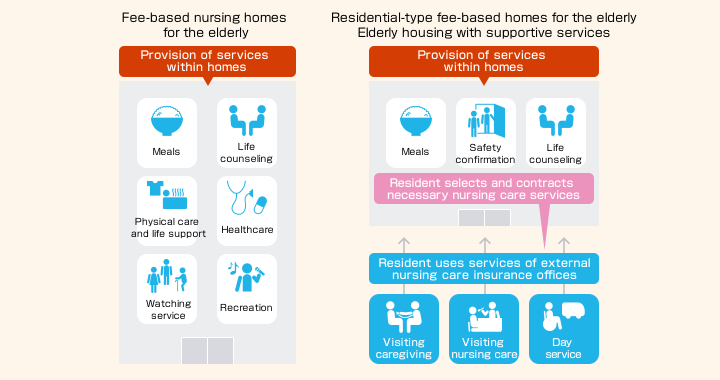
- Assets acquired by Daiwa Securities Living Investment Corporation and healthcare facilities to be acquired in the future do not necessarily provide all of the services above.
- Rent:
